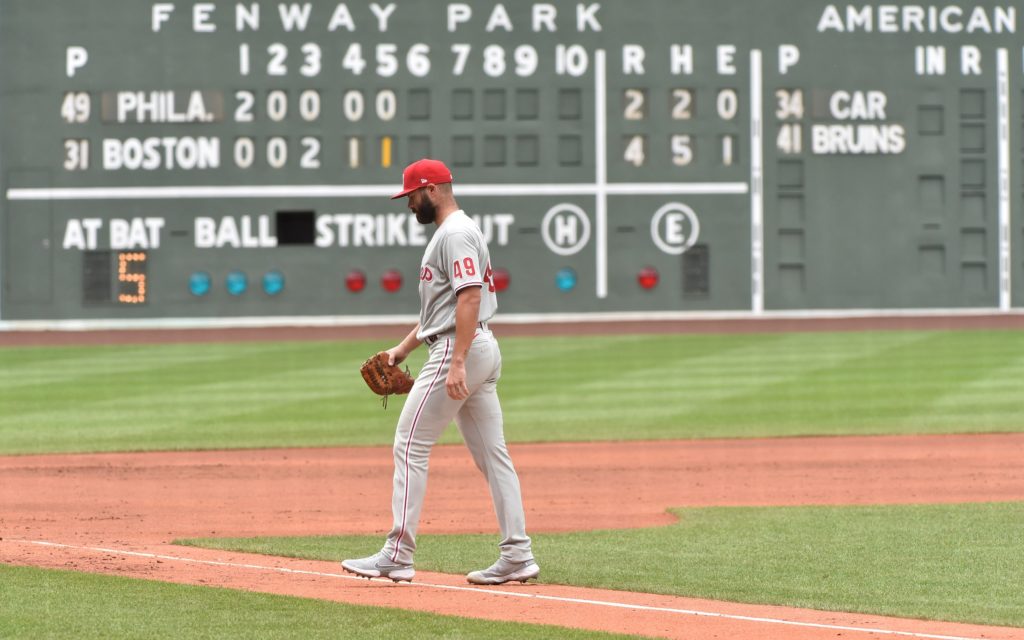Ad Disclosure
If You Don’t Know How to Feel About the Phillies Yet, You’re Not Alone
By Bob Wankel
Published:

If you feel like a crazy person watching the Phillies seesaw their way through the first third of a disjointed and abbreviated schedule, your instability is understandable. The way it feels like you’re supposed to view this team changes on what seems like a daily basis.
Complicating matters is that you must find a way to balance the typical patience and restraint needed during traditional baseball viewing with a new urgency and understanding that everything carries more importance and more weight in a 60-game sprint.
I can’t think of a better way to describe the difficulties of such a balancing act than this. Last season, the Phillies finished their 19th game of the season on April 19th. This season, the Phillies’ 19th game was played less than two weeks away from the trade deadline. If that’s a shock to the way fans typically consume the game, imagine what it is like for talent evaluators and decision-makers.
Following a frustrating 6-3 loss yesterday that snapped both the Phillies’ own four-game winning streak and the Red Sox’ nine-game losing streak, there are two very different ways to view this team right now, and its offense best exemplifies the conundrum.
It is difficult to knock the production of this lineup – even after a day in which it produced just one hit over the final eight innings of a listless loss. Just look at these National League rankings:
- AVG: .260 (4th)
- OBP: .344 (2nd)
- SLG: .463 (1st)
- wOBA: .346 (1st)
- OPS: .807 (1st)
- wRC+: 118 (2nd)
These are core evaluation metrics that combine to reveal the story of an offense’s performance.
From a more digestible standpoint, the Phillies are also tied with the Dodgers for an MLB-best 5.58 runs per game, while posting a National League-best 19.4% strikeout rate.
In short, collectively, the Phillies hit for average, power, efficiency, and they put the ball in play. These are each encouraging signs.
And, yet, the Phillies also have three regulars currently hitting .210 or below.
Their utility man turned everyday second baseman turned utility man once more, Scott Kingery, is hitting .115 with an unthinkable .279 OPS. Another way to look at Kingery’s rough start: Boston’s Rafael Devers had as many hits in two games against the Phillies as Kingery has produced in 15 games (52 at-bats) this season.
Andrew McCutchen, who has swung the bat better in recent days, still owns just a .555 OPS. Rhys Hoskins, who ended a 127-plate appearance home run drought on Tuesday night, remains an on-base machine but has failed for over a year now to consistently display the requisite power needed for a productive first baseman.
That’s what makes the overall production of this lineup such an interesting study.
Kingery’s role moving forward may be diminished, but the Phillies must rely on McCutchen and Hoskins. Do these players continue to make the incremental progress they’ve demonstrated in recent days?
At the same time, can Bryce Harper and J.T. Realmuto – the two players most responsible for the lineup’s league-best output – continue to produce at such an exceptionally high level?
One truth that has crystalized through 19 games is that the Phillies are likely to go only as far as the offense takes them, unless, of course, you foresee a swift 180 from what continues to be a historically bad bullpen. I, for one, do not foresee that coming.
Its 8.19 ERA, which is well more than a run worse than the 29th ranked Mariners’ 6.34 bullpen ERA, continues to stunt their attempts to get on the plus side of the .500 mark.
The starters, meanwhile, have worked to a respectable 4.01 ERA, but much of that production is boosted by the hot starts of Aaron Nola and Zack Wheeler. The Phillies must get more, in terms of both the quality and quantity of innings, from the quartet of Zach Eflin, Jake Arrieta, Spencer Howard and Vince Velasquez (who remains a factor because of the hefty dose of forthcoming doubleheaders).
The good news as you ride what is, at times, a nauseating and what is, at times, an exhilarating early-season roller coaster is that the Phillies’ erratic start has not buried them in what remains a wide-open division. Atlanta’s injury situation has prevented a runaway, while the other contenders have battled with their own inconsistencies.
I guess what I’m trying to say is this. As you continue to justifiably grapple with how to feel about what you’re watching, just know that you’re right for wanting to be patient. You’re right for wanting to slam the panic button. You’re right to believe the Phillies can make a run. You’re right to believe the Phillies are likely headed nowhere. And, most of all, you’re right to have no idea what to believe about a baseball team whose regular season is set to end in just 38 days.
Bob Wankel covers the Phillies for Crossing Broad. He is also the Vice President of Sports Betting Content at SportRadar. On Twitter: @Bob_Wankel E-mail: b.wankel@sportradar.com